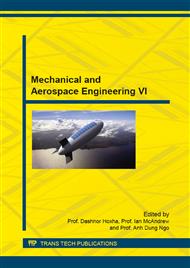[1]
Busemann A., Aerodynamic Lift at Supersonic Speeds. The 5th Volta Aerodynamic Conference, Volta, Italy, October 3, (1935).
Google Scholar
[2]
Licher R.M., Optimum Two-Dimensional Multiplanes in Supersonic Flow. Douglass Aircraft Conference, USA, (1955).
Google Scholar
[3]
Hua R. H., Ye Z. Y., Drag Reduction Method for Supersonic Missile Based on Busemann Biplane Concept. Chinese Journal of Applied Mechanics, Vol. 29 (2012), pp.536-540 (in Chinese).
Google Scholar
[4]
Xu Y. Z., Xu Z. Q., Li S. G., et al., A Hypersonic Lift Mechanism With Decoupled Lift and Drag Surfaces. Science China: Physics, Mechanics & Astronomy, Vol. 56 (2013), p.981–988.
DOI: 10.1007/s11433-013-5078-5
Google Scholar
[5]
Kusunose K., A Fundamental Study for the Development of Boomless Supersonic Transport Aircraft. The 44th AIAA Aerospace Sciences Meeting and Exhibit, Reno, USA, January 9-12, (2006).
DOI: 10.2514/6.2006-654
Google Scholar
[6]
Matsushima K., Takanashi S., An Inverse Design Method for Wings Using Integral Equations and Its Recent Progress. Proceedings of Lectures and Workshop International Recent Advances in Multidisciplinary Technology and Modeling, Japan, (2008).
DOI: 10.1007/978-3-322-89952-1_8
Google Scholar
[7]
Kuratani N., Ogawa T., Yamashita H., Yonezawa M., and Obayashi S., Experimental and Computational Fluid Dynamics Around Supersonic Biplane for Sonic-Boom Reduction. 13th AIAA/CEAS Aeroacoustics Conference (28th AIAA Aeroacoustics Conference), AIAA Paper 2007-3674, (2007).
DOI: 10.2514/6.2007-3674
Google Scholar
[8]
Kashitani M., Yamaguchi Y., Kai Y., and Hirata K., Preliminary Study on Lift Coefficient of Biplane Airfoil in Smoke Wind Tunnel. 46th AIAA Aerospace Sciences Meeting and Exhibit. AIAA Paper 2008–349, Jan. (2008).
DOI: 10.2514/6.2008-349
Google Scholar
[9]
Kusunose K, Matsushima K., Maruyama D., Supersonic Biplane—A Review. Progress in Aerospace Sciences, Vol. 47 (2011), pp.53-87.
DOI: 10.1016/j.paerosci.2010.09.003
Google Scholar
[10]
Masahito Y., Shigeru O., Aerodynamic Performance of the Three Dimensional Lifting Supersonic Biplane. Journal of Aircraft, 47 (2010), pp.983-990.
DOI: 10.2514/1.46651
Google Scholar
[11]
Wataru Y., Kazuhiro K., Biplane-Wing/Twin-Body-Fuselage Configuration for Innovative Supersonic Transport. Journal of Aircraft, 51 (2014), p.1942-(1952).
DOI: 10.2514/1.c032581
Google Scholar
[12]
Maruyama D., Matsuzawa T., Kusunose K., Matsushima K., and Nakahashi K., Consideration at Off-design Conditions of Supersonic Flows Around Biplane Airfoils, " 45th AIAA Aerospace Sciences Meeting and Exhibit, AIAA Paper 2007-687, Jan. (2007).
DOI: 10.2514/6.2007-687
Google Scholar
[13]
Yamashita H., Yonezawa M., Obayashi S., and Kusunose K., A Study of Busemann-Type Biplane for Avoiding Choked Flow. 45th AIAA Aerospace Sciences Meeting and Exhibit, AIAA Paper 2007-688, Jan. (2007).
DOI: 10.2514/6.2007-688
Google Scholar
[14]
Hu R., Jameson A., Wang Q. Q., Adjoint-based Aerodynamic Optimization of Supersonic Biplane Airfoils. Journal of Aircraft, Vol. 49 (2012), pp.802-814.
DOI: 10.2514/1.c031417
Google Scholar
[15]
Jiang Y. W., Methodology of Generalized Mesh and Its Application to Solve the Navier-Stokes Equations. PHD paper of Northwestern Polytechnical University. (2013).
Google Scholar
[16]
Rendall T.C.S., Allen C.B. Efficient Mesh Motion Using Radial Basis Functions with Data Reduction Algorithms. Journal of Computational Physics, Vol. 228 (2009) pp.6231-6249.
DOI: 10.1016/j.jcp.2009.05.013
Google Scholar


